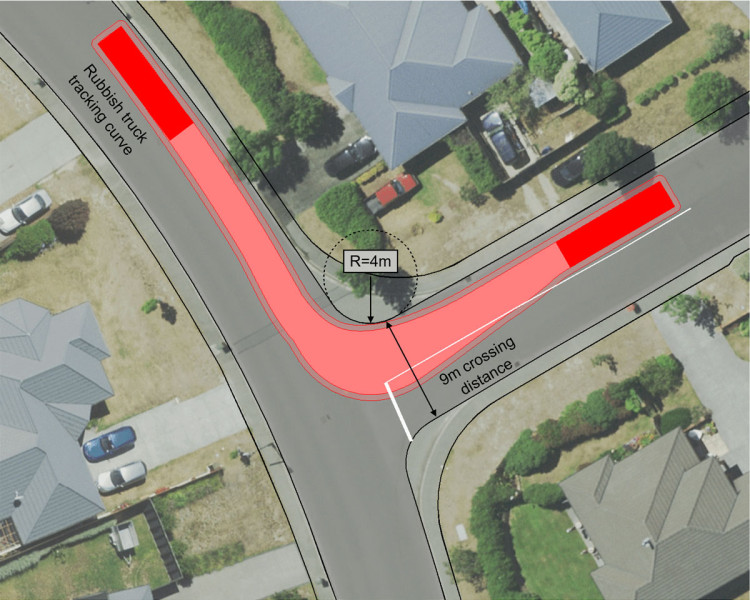Kerb radii at corners that are designed to accommodate the largest possible vehicle turning at a high speed degrades the pedestrian environment and can result in longer crossing distances[1][2]. Larger radii can also mean pedestrian crossing facilities are located further from pedestrian desire lines or the pedestrian through route meets a curved kerb at a crossing point. The latter situation can make it more difficult to design kerb ramps and arrange tactile indicators to give clear and consistent messages to pedestrians.
Instead, the kerb radii at corners should be minimised as this reduces vehicle turning speeds and provides a safer and more comfortable environment for pedestrians including reduced crossing distances which take less time to cross and therefore reduce exposure for pedestrians.
It is important to select an appropriate design vehicle and a check (or control) vehicle for the street type and context. The design vehicle is the largest vehicle that frequently uses a street. This could be a standard 85th percentile car for Local Streets, or a standard bus if on a scheduled bus route. Design vehicles are expected to stay within their allotted traffic lane when making a turn. Check or control vehicles are larger vehicles that may use a street from time to time (up to a few times a week), for example, this could be a rubbish truck on Local Streets. Check vehicles should be accommodated assuming they are travelling at low speeds and allowing them to use multiple lanes, including adjacent or opposing traffic lanes depending on the movement function of the respective streets.
The first diagram below shows an intersection in a residential area with a large corner radius (11m) that allows large vehicles such as a rubbish truck (the Check vehicle) to easily turn but results in a long crossing distance of about 14m for pedestrians. The second diagram shows the same intersection but retrofitted with a smaller corner radius (4m) which significantly shortens the crossing distance for pedestrians to about 9m and requires the rubbish truck to track across the opposing traffic lane and at a slower speed which is acceptable in a residential context. In a new build urban environment the second example with the reduced kerb radii is a better outcome.

Poor practice example of a large corner radius at a residential intersection resulting in a long crossing distance for pedestrians.

Retrofitting smaller corner radii at a residential intersection would result in a shorter crossing distance for pedestrians. Note the turning vehicle would cross into the opposing traffic lane.
The photo below shows a tight corner radius at a signalised intersection which will minimise turning vehicle speeds and allows the pedestrian crossing facilities to be located on pedestrian desire lines.

Example of tight corner radii at signalised intersection, Wellington (Photo: Jeanette Ward)
Further guidance on the position of kerb ramps for crossings is available in Designing for blind and low vision people.
PNG: Designing for blind and low vision people
RTS14 - Guidelines for facilities for blind and vision impaired pedestrians [PDF, 1.6 MB]